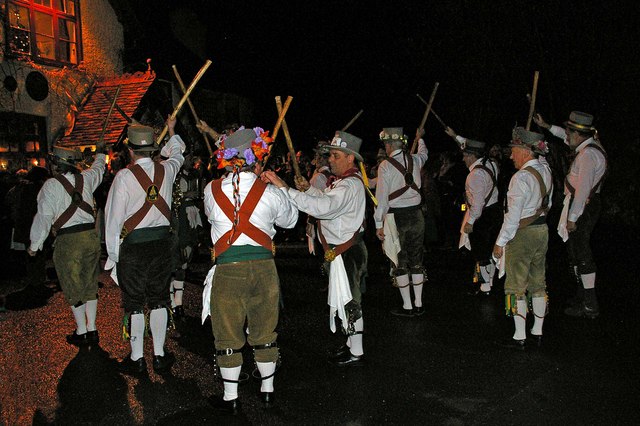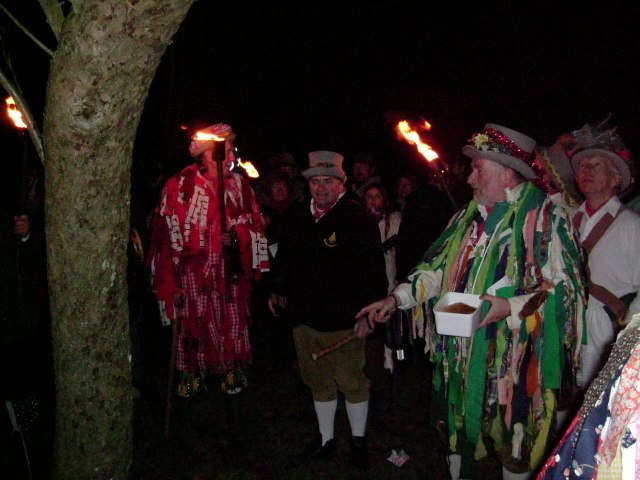Orchard wassailing is an indigenous English ritual with records dating back as far as the 11th century, and is still performed by the tribes of the South West in cider orchards
Here we come a-wassailing! Traditionally performed on the 12th night after Christmas, January 5th or 6th, some people may accuse me of being a whole day late with this post. It’s not a day late, it’s 364 days early.
But for those of us old enough to remember using the Julian calendar, “Old Twelvey Night” is January 17th, so I win either way, which is what really matters.

The resurgence of cider’s popularity has led to more apple and pear orchards being restored and planted, and ancient rituals like wassailing revived.
The word wassail has its origins in Old Norse ves heill “be healthy,” likely brought to England by the Danish invaders led by Halfdan Ragnarsson in 865 AD.
It evolved into an Anglo-Saxon greeting, Wæs þu hæl, be thou hale, to which the response is Drinc hæl, drink and be healthy.
But pagan abundance rituals are as old as humanity, and wassailing is probably a descendant of sacrifices to Pomona, goddess of fruit trees and orchards, as is apple bobbing on Halloween.
What is Wassailing About?
The modern understanding of the purpose of wassailing is to wake the trees from their winter slumber, scare away bad spirits, and toast the health of the trees to ensure a bumper harvest come the autumn.
But as with so many things about our own history, it is entirely possible that we have most of that backwards.
After all, a tree performs its wonders without human assistance or visible effort; it is us who need rituals to remember ourselves, to sustain and direct us into healthy and productive lives of service to our family, clan, and nation.
Could it be that these rituals were rooted in a profoundly dependant relationship with, and obedience to, the trees that nourish us?
Trees may or may not be afflicted by evil spirits, but people certainly are afflicted by the spirits of sloth, envy, pride, and depression: all of which are scientifically proven to be cured by dressing up fancy, drinking cider, dancing out in the fresh air, and shooting guns or banging on pots if you can’t afford to waste the ammo.
Another explanation was provided by a local farmer in his 90’s, who had outlived his wife and three children. He said, “farming is largely pleading with the soil, plants, and animals, beseeching them to do it all over again for another year.”
Wassailing is most common in the West of England: Somerset, Dorset, Devon, Gloucestershire, and Herefordshire.
These counties were well known for their special varieties of apples and pears, with higher levels of bitter tannins and acidity making them unsuitable for eating, but perfect for the production of ciders, scrumpy, and perry.
The custom became especially important around the 16th and 17th centuries, where cider orchards were so commonplace across the southern parts of England that farm labourers were part paid in cider, up to eight pints a day.
This method of payment was banned by The Truck Act of 1887, and it’s been downhill for us ever since.
How to Wassail
Before the wassailing ceremony, the wassailing drink is prepared. This was made in a special ceremonial bowl shaped like a large goblet, and may have been made from ceramic, turned wood or in a few wealthy cases, silver.
But a big old kettle is fine:
The recipe of the drink varies from region to region. Some of the oldest recipes are based on a hot spiced ale rather than cider, some of which call for the addition of eggs, cream, sugar and roasted apples to make a drink known as ‘Lambs Wool’. These days, mulled cider is most common.
The ceremony likewise varied from region to region, as is proper with all things local: I’m sorry Sir, this is not a MacDonalds.
In general, wassailing began just before dark, when the local people gathered to be led by a wassail king and/or queen in procession to the orchard.
They would bring the prepared drink, along with pots and pans, sticks, buckets, whistles, muskets (later shot guns) and other noise making items.
On reaching the orchard, the crowd would gather round the oldest tree, where there would be speeches to praise it and its bounteous crops of previous seasons, imploring it to perform as well, if not better, in seasons to come.
Each participant would drink from the goblet and toast the tree’s good health with a song or rhyme.
An example of a toast originating in Devon:
Health to thee, good apple tree, Well to bear pocket fulls, hat fulls, Peck fulls, bushel bag fulls!
Another from Gloucestershire:
Blowe, blowe, bear well,
Spring well in April,
Every sprig and every spray,
Bear a bushel of apples against,
Next new years day!Then the crowd would beat their pots and pans, knock on the trunk with their sticks, and fire their guns into the highest branches, creating as much ruckus as they possibly could in order to wake the tree and to scare away evil spirits.
Finally, offerings of toast that had been soaked in the ceremonial drink were placed in nooks and forks in the tree’s branches to appease the robins, one of evil spirits’ main predators.
More drink was sloshed over the trunk and around the base of the tree, the remainder being finished up by the participants.
Where Can I Wassail in 2025?
Despite the uncharacteristic tardiness of this post, there are still some wassailing events to get involved in across the country, mainly in the West.
Why not organise one in your garden or at your local orchard?

